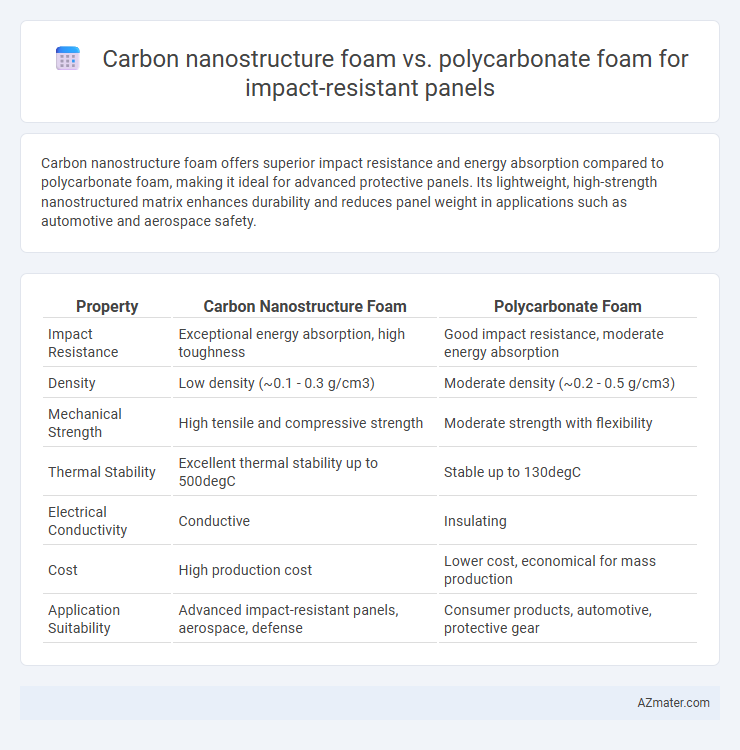Carbon nanostructure foam offers superior impact resistance and energy absorption compared to polycarbonate foam, making it ideal for advanced protective panels. Its lightweight, high-strength nanostructured matrix enhances durability and reduces panel weight in applications such as automotive and aerospace safety.
Table of Comparison
| Property | Carbon Nanostructure Foam | Polycarbonate Foam |
|---|---|---|
| Impact Resistance | Exceptional energy absorption, high toughness | Good impact resistance, moderate energy absorption |
| Density | Low density (~0.1 - 0.3 g/cm3) | Moderate density (~0.2 - 0.5 g/cm3) |
| Mechanical Strength | High tensile and compressive strength | Moderate strength with flexibility |
| Thermal Stability | Excellent thermal stability up to 500degC | Stable up to 130degC |
| Electrical Conductivity | Conductive | Insulating |
| Cost | High production cost | Lower cost, economical for mass production |
| Application Suitability | Advanced impact-resistant panels, aerospace, defense | Consumer products, automotive, protective gear |
Introduction to Impact-Resistant Panel Materials
Carbon nanostructure foam exhibits exceptional impact resistance due to its high strength-to-weight ratio and superior energy absorption capabilities, outperforming traditional materials like polycarbonate foam. Polycarbonate foam, while lightweight and moderately resilient, often falls short in dissipating high-impact forces compared to the advanced nanoscale architecture of carbon foam. The unique microstructure of carbon nanostructure foam enhances durability and mechanical performance, making it a cutting-edge choice for impact-resistant panel applications in aerospace and protective gear industries.
Overview of Carbon Nanostructure Foam
Carbon nanostructure foam exhibits exceptional impact resistance due to its lightweight, high surface area, and remarkable mechanical strength derived from interconnected carbon nanotubes or graphene layers. This foam offers superior energy absorption and deformation recovery compared to conventional materials, making it ideal for advanced protective panels. Its thermal stability and electrical conductivity further enhance performance in demanding environments where polycarbonate foam typically falls short.
Polycarbonate Foam: Composition and Properties
Polycarbonate foam is a lightweight, thermoplastic polymer foam known for its excellent impact resistance, high tensile strength, and dimensional stability. Its cellular structure provides superior energy absorption and thermal insulation, making it ideal for impact-resistant panels in automotive and aerospace applications. The foam's chemical resistance and flame retardancy further enhance its durability and safety in harsh environments.
Comparative Mechanical Strength
Carbon nanostructure foam exhibits significantly higher mechanical strength compared to polycarbonate foam, offering superior impact resistance and energy absorption capabilities. Its tensile strength can exceed that of polycarbonate foam by up to five times, with enhanced stiffness and resilience under high strain rates. The lightweight nature combined with exceptional durability makes carbon nanostructure foam the optimal choice for high-performance impact-resistant panels.
Impact Absorption and Energy Dissipation
Carbon nanostructure foam exhibits superior impact absorption and energy dissipation compared to polycarbonate foam due to its high surface area and interconnected porous network, which efficiently distributes and absorbs impact energy. Its nanostructured framework enables rapid deformation and recovery, enhancing durability under repeated high-impact loads. Polycarbonate foam, while lightweight and flexible, generally provides less effective energy dissipation and impact resistance, limiting its suitability for applications requiring extreme shock attenuation.
Thermal Stability and Environmental Performance
Carbon nanostructure foam exhibits superior thermal stability compared to polycarbonate foam, maintaining structural integrity at temperatures exceeding 1000degC, whereas polycarbonate foam begins to degrade around 130degC. The high thermal resistance of carbon nanostructures ensures consistent impact protection in extreme heat environments, making it ideal for aerospace and automotive applications. Environmentally, carbon nanostructure foam offers enhanced recyclability and lower volatile organic compound (VOC) emissions, reducing its ecological footprint relative to petroleum-based polycarbonate foam.
Weight and Density Analysis
Carbon nanostructure foam exhibits a significantly lower density, typically ranging from 0.05 to 0.1 g/cm3, compared to polycarbonate foam, which generally ranges from 0.2 to 0.5 g/cm3. This reduced density contributes to a lighter overall panel weight without compromising impact resistance, making carbon nanostructure foam ideal for applications requiring high strength-to-weight ratios. Weight savings from the carbon nanostructure foam can improve energy absorption efficiency and enhance structural performance in impact-resistant panels.
Cost-effectiveness and Scalability
Carbon nanostructure foam offers superior impact resistance and lightweight properties but remains costly due to complex manufacturing processes and limited large-scale production capabilities. Polycarbonate foam provides a more cost-effective and scalable solution, leveraging established industrial fabrication methods and lower material expenses while maintaining acceptable impact absorption performance. For impact-resistant panels, polycarbonate foam presents an optimal balance between affordability and mass production potential, whereas carbon nanostructure foam suits high-performance, niche applications with budget flexibility.
Applications in the Industry
Carbon nanostructure foam offers superior impact absorption and energy dissipation compared to polycarbonate foam, making it ideal for aerospace, automotive, and protective gear applications where lightweight durability is critical. Its high surface area and exceptional mechanical strength enable enhanced vibration damping and thermal stability under extreme conditions. Polycarbonate foam remains popular in packaging, cushioning, and industrial insulation due to its cost-effectiveness and ease of manufacturing but lacks the advanced impact resistance properties necessary for high-performance protective panels.
Future Prospects and Innovations in Foam Technology
Carbon nanostructure foam offers superior impact resistance and energy absorption compared to traditional polycarbonate foam, driven by its lightweight and high-strength carbon nanomaterials such as graphene and carbon nanotubes. Emerging innovations include hybrid foams that integrate carbon-based nanostructures with polycarbonate matrices to enhance mechanical performance and thermal stability, expanding applications in aerospace and automotive industries. Future prospects focus on scalable manufacturing techniques and eco-friendly production processes to facilitate the widespread adoption of carbon nanostructure foams in advanced impact-resistant panels.

Infographic: Carbon nanostructure foam vs Polycarbonate foam for Impact-resistant panel
 azmater.com
azmater.com